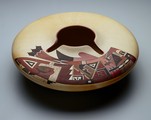
 |
Dextra Quotskuyva |
Pueblo pottery is often made of clay from sources discovered by the potter. The clay is considered a sacred gift; potters make offerings of cornmeal and ask permission to take it from Mother Earth. Once the clay has been dug and transported, it must be processed. Water is used to dissolve out minerals; other impurities such as stones, twigs, and roots are sieved and sifted out. The clay is then mixed with TEMPER—usually sand, finely ground rock, or crushed POTSHERDS—which will ensure slow, even drying of the pots without cracking.
Traditionally, women shaped pots, and men helped with mixing the clay or with painting. Today both men and women make pots, using the hand-built COILING METHOD. Out of respect for the old ways, potters use their hands, not machines: pottery is never THROWN on a wheel. To begin, a base is patted out much as dough is flattened out to make tortillas. If the pot is larger than the palm of the hand, it is placed on a base called a PUKI, which is used to support the coils as they are added. A puki can be anything that will hold the pot, from a china plate or cereal bowl to a pie tin. After pinching a rim around the edge of the base, the maker rolls the first coil of moist clay and adds it to the inside edge. Coils are added one by one, as the potter turns the puki, making sure the clay remains moist enough to adhere properly. Air bubbles are constantly kneaded out, as they could ruin the pot when fired.
An essential part of shaping the pot is called scraping. Working with speed and care, the potter uses a scraper made from a potsherd, gourd rind, or more contemporary material such as an eyeglass lens, to thin the walls and smooth out the coil junctions. Dextra Quotskuyva speaks of this process as the pot "molding itself"; she is there "to guide it the way it wants."1 After the pot has dried, its final form is achieved by additional scraping and sanding. Sanding has traditionally been done with corncobs, lava rocks, or sandstone; today potters also use window screen, steel wool, sandpaper, or metal tools. Minor imperfections can be smoothed out with wet clay or a wet cloth, but pots with major flaws must be broken and recycled with the next batch of clay.
Next the potter creates a lustrous shine by carefully hand rubbing the pot with a polishing stone or clean rag. Quotskuyva uses a polishing stone that was her mother's. Pueblo familes often pass down objects used in making pottery as part of their tradition. Polishing requires great skill and concentration to avoid scratching the pot.
Now the pot is ready for the last step before firing: painting. The black paint used is a mixture of GUACO (a residue resulting from boiling down Rocky Mountain bee plant) and tansy mustard. The plants are also gathered with prayers and ceremonies. OCHER or iron-rich mineral PIGMENTS, ground rock, and clay are mixed with a liquid binder to create red, brown, and yellow paints. Brushes are made from a dried yucca leaf that has been chewed down to a few fibers for bristles. Designs are painted on freehand and sometimes made up as they are added.
The potter builds an outdoor KILN from scratch each time pots are fired. She places the pots on a grate a few inches off the ground and stacks kindling underneath. Then she covers the pots with broken pottery, tin, old bedsprings, or other metal pieces to protect them from the fire. The fuel, usually cakes of sheep or cow manure mixed with pieces of wood and bark, is stacked around the outside and ignited. Firing is a risky part of the process; a few pots are always ruined. Some potters make an offering before lighting the fire, or have the ground blessed by a holy man. The potter has a sense, from experience, of how long the fire needs to be tended and when she can let it burn down. Overfiring can cause the pots to turn dull. Not all the pots are "meant to be." Some of them explode, or air bubbles in the clay pop. Every potter keeps a few cracked pots in her home, believing that pots, like people, are valuable, even when imperfect.2
Notes
1. Martha Hopkins Struever, "Potter Dextra Quotskuyva," Indian Artist (Summer 1996), p. 60.
2. The technique used for making and firing pottery is explained in Stephen Trimble, Talking with the Clay: The Art of Pueblo Pottery (Santa Fe, New Mexico: School of American Research Press, 1987), pp. 9-28.

Key ideas.
Where does it come from?
What does it look like?
How was it used?
How was it made?
Discussion questions.
Additional resources.
Select another piece.